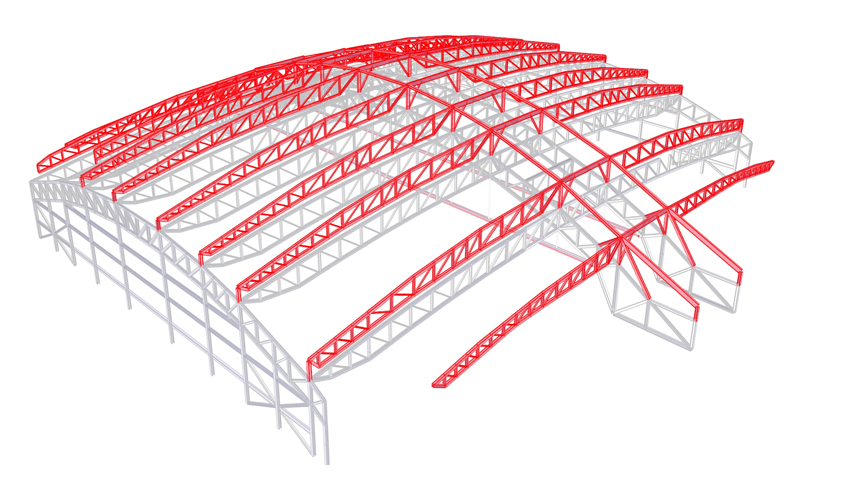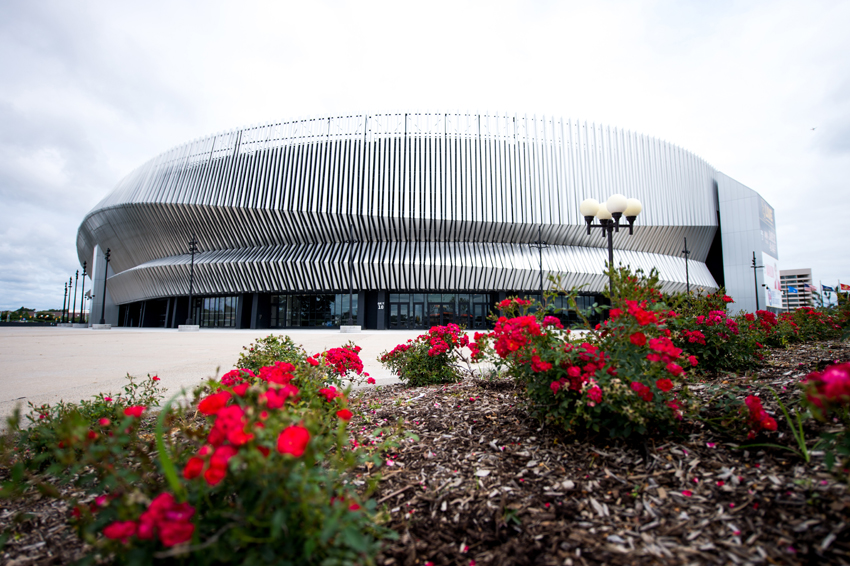Adapting to Change: Arenas Rely on Steel
Barclays Center Green Roof
The second chapter of the Barclays Center story is the arena’s 135,000-square-foot green roof addition, also designed by AECOM an SHoP Architects.
“The green roof addition served a dual purpose by providing a visual amenity to the inhabitants of the surrounding new residential construction and a means of improving the acoustic performance to minimize sound transmission outside of the arena,” explains Callow.
To achieve acoustical performance targets, the green roof needed to be separated from the main roof structure by an air gap, which also provided the ideal space to locate new structural elements. While the original structural foundations were designed to support the load of a green roof, this was not the case for most of the superstructure, including the long-span roof.
To minimize penetrations to the existing roof and retrofit work to the side trusses spanning between tied arches that would be difficult to access above the bowl, new trusses were introduced in the air gap space above the current roof to span from the existing tied arches to the perimeter of the building, according to Callow.
ach arch was retrofitted with two 33⁄4-inch-diameter, 300-foot-long steel cables, the type and size more commonly used in bridge construction. The cables were pretensioned to relieve some of the load in the existing tie and provide the entire system with more axial capacity. To connect the cables and transfer the load into the existing structure, new 3-inch-thick cable gusset assemblies were welded to each side of the existing 3-inch-thick arch node.

Image courtesy of Thornton Tomasetti
Supplementary steel trusses are installed above the existing roof to increase the capacity to create the Barclays Center green roof.
A new arch-shaped top chord was also posted up from the existing tied arches to increase the overall depth of the tied arch system and subsequently improve its load-carrying capacity. This additional chord is 14 feet above the existing arch chord and is tied into the existing arches with a vertical element at each major panel point and diagonal a bracing elements at the ends of the span. In doing so, the effective depth of the arch under live loads and the weight of the new roof increased from 50–64 feet, with a proportionate decrease in member stresses.
In addition to the new elements that were constructed over the existing roof, the existing tension tie was reinforced with a pair of cables on each side of it to increase the tensile capacity of the tie.
To address the erection challenges inherent in transporting the large truss members for installation, ASTM A913 Grade 65 steel was used to reduce their weight. Mid-span shoring posts supported on the existing roof trusses below allowed each of the 170-foot secondary trusses to be erected in two segments with weights under the limiting pick capacity of each crane. Lightweight joists were used to provide infill framing, further reducing the weight of the overall structure and increasing the speed of erection.
Ultimately, a highly integrated building team succeeded in performing green roof retrofit with minimal impact to the arena’s busy event schedule.
Nassau Veterans Memorial Coliseum
The Nassau Veterans Memorial Coliseum in Uniondale, New York, a 416,000- square-foot, multipurpose arena best known for hosting NHL New York Islander and American Basketball Association New York Nets games, was recently reclad with approximately 4,700 unique aluminum fins, a move that breathed new life into the 1970s facility.

Photo: Jamey Price Photography; courtesy of 3A Composites USA
Breathing new life into the Nassau Veterans Memorial Coliseum in Uniondale, New York, approximately 4,700 unique aluminum fins were used to reclad the 416,000-square-foot facility. The canopy cantilevers approximately 85 feet from the primary building and features an open-air oculus in the center with large curved video boards.
“Each of the elements in this system varies slightly in profile and dimension to create a subtle flow that reflects the big skies of the flat Long Island landscape,” states SHoP Architects, the project’s architect, in a description of the project.
Instead of tearing down and rebuilding the facility, the project successfully met the Coliseum’s needs to provide a state-of-the-art, regularly used venue at a fraction of the budget.
A highly integrated building team essentially put their heads together to come up with an efficient and effective way to marry the building enclosure’s new shape and a new form without forcing that design upon the structure.
One major issue was how to attach the cladding. The initial schematic design employed steel structural channels, but this would have involved going behind the existing concrete siding. Building enclosure subcontractor Crown Corr then proposed a space-frame construction approach. Not only did this circumvent the risk and cost of penetrating the arena, but it embellished SHoP Architects’ vision for a reinvented skin.
“Instead of channels and angles installed behind the fins, now there would be tubes and space-frame nodes,” relates Cerone. At the same time, SHoP Architects needed to understand the aesthetic implications of this change. Fortunately, it was easy to model the change and the architects were happy with the results. More specifically, the architect utilized a high-fidelity digital process, leveraging LiDAR scanning to survey and model existing conditions, to which design models were tailored, coordinated, and evolved into fabrication. “Structural steel aided the process due to the accuracy of fabrication tolerances,” he adds.
Going into more detail about this innovative attachment approach, Thornton Tomasetti’s Callow explains that the existing building had 32 radial perimeter concrete columns shaped like a U. “Through coordination with SHoP Architects and Crown Corr, we developed a detail where a short horizontal steel member would be connected between the two stems of the U-shaped column. By utilizing the cavity, we were able to connect the member to the existing concrete column using a shear transfer rather than a direct face mounted tension connection.”

Photo courtesy of Thornton Tomasetti
Nassau Veterans Memorial Coliseum’s new facade panels contain a secondary steel backup system that spans to existing building columns.









